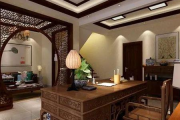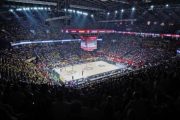Squash is an amazing sport to play as it is extremely challenging and very fast moving game. A large number of new squash courts are currently being built, and how to build a standardized squash court has become a hot topic. For those who love squash, how to choose a comfortable squash court is the most important issue, the following mainly introduces some knowledge about squash courts.
Squash is a racket and ball sport played by two (singles) or four players (doubles squash) in a four-walled court with a small, hollow rubber ball. The players alternate in striking the ball with their racquets onto the playable surfaces of the four walls of the court. The objective of the game is to hit the ball in such a way that the opponent is not able to play a valid return. About 20 million people play squash regularly world-wide in over 185 countries.
Standard squash court size:
The dimensions of a standard single squash court are:
Length of the court- 9.75m.
Width of the court- 6.4m.
Diagonal- 11.665m.
Height from floor to lower edge of front wall line- 4.57m.
Height from floor to lower edge of back wall line- 2.13m.
The dimensions of a doubles/hardball squash court are:
Length of court between playing surfaces- 13.72m.
Width of court between playing surfaces- 7.62m.
Diagonal- 15.69m.
Height above floor to lower edge of front wall line- 6.09m.
Height above floor to lower edge of back wall line- 2.13m.
What is a regulated squash court?
According to the WSF squash court specification, the inner dimensions of the squash court are 6,4 m width and 9,75 m length. Nevertheless the necessary installation dimensions of the squash court differ from those numbers, due to different width or characteristics of the various kind of squash court walls. During the planning of squash courts it is extremely important to define the squash walls, otherwise the courts will not have the necessary dimensions.
Comfortable temperature conditions
The WSF recommends that a Squash court and any adjacent spectator areas (including the space for the marker and referee) should be provided with a heating and/or air conditioning system, which is capable of maintaining a temperature of between 10 and 25 degrees Celsius with an ideal range between 15 to 20 degrees. The court and any adjacent spectator areas shall be provided with a ventilation system that provides not less than four complete air changes per hour
Light coloured wood
To comply with WSF requirements, floors should be constructed with light coloured wood to enable the fast-moving ball to be seen in play and have a dense structure such as beech, ash or maple, finished with textured surface for grip. All floors should correspond to the EN norm 14904 in order to guarantee the best playing characteristics. The recommended construction height inclusive the necessary tolerance is 100 mm.
Ceiling with sound absorbing materials
Squash courts do not require special ceilings. It is important to consider that the balls won‘t be get stuck in any overhead areas. With concrete ceilings it is important to have sound absorbing materials to avoid any disturbance due to an echo. It has to have a simple shape, a matt finish and a light colour, so the players are able to see the ball without difficulties
Lighting and ventilation
The minimum lighting level for a standard squash court according to the World Squash Federation Squash Court Specification is minimum 300 Lux (but 500 Lux is recommended) measured at 1 metre above finished floor level. It is important that the lighting is evenly, uniformly and does not vary at any point by more than 15%.
How many light does a single standard squash court need?
According to the World Squash Federation Specifications, 500 lux is needed for non-televised events, the minimum standard lux is at least 300 lux. As for TV standard, it is at least 1200 lux
On average, the standard size of the a single squash court: Length of the court is 9.75m, Width of the court is 6.4m, the total area is 62.4 square meter.
So, in minimum standard, you will 300 x 62.4 = 18,7200 lumens to brighten up the outdoor squash court for recreational or backyard events.
Want to light up a squash court?
If you want to light up a new squash court and don’t know what to do, you can read this article first. Factors to Consider in Squash Court Lighting.If you need some help pls contact us .
We will adopt DIALux and other relevant software to generate the photometric plan for the squash court lighting projects. The idea is that we simulate the environment and lighting effect on the sports ground before real installation. In other words, it is like a proposal of a lighting project. Our lighting engineers arrange the luminaires and output the false color rendering, isoline and other graphs to predict the ground brightness and uniformity.
Some interesting facts about squash:
The first players used rubber balls, which, when hit, squashed against walls (hence the name “squash”).
Squash is being applied as an Olympic competition (supporters of the sport are lobbying for its inclusion).
It’s been voted the healthiest sport to play by Forbes magazine based on cardiorespiratory endurance, muscular strength, flexibility, muscular endurance, calories burned, and risk of injury. An hour of squash can burn 600-1000 calories.







